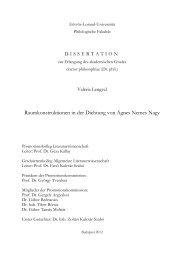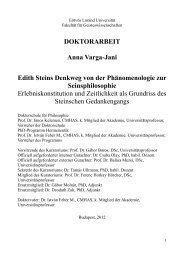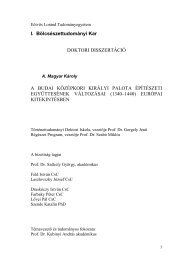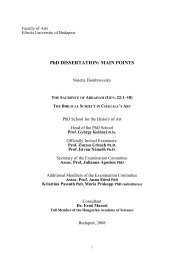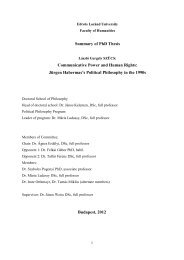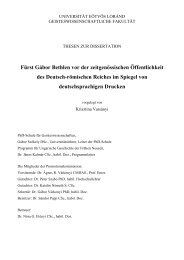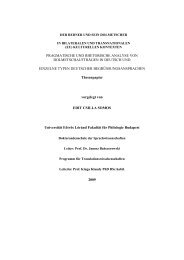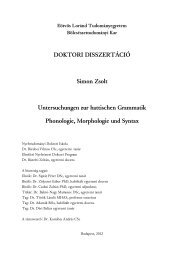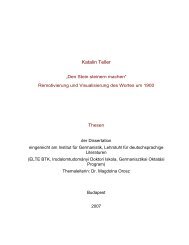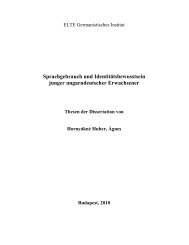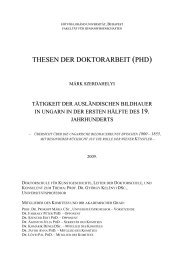Zsuzsanna Kutasi - ELTE BTK disszertációk
Zsuzsanna Kutasi - ELTE BTK disszertációk
Zsuzsanna Kutasi - ELTE BTK disszertációk
Create successful ePaper yourself
Turn your PDF publications into a flip-book with our unique Google optimized e-Paper software.
the coffin bone and the frog ~ cartilage, small bone in the knee ~ patella, small bone between<br />
the cannon and the pastern), ma’bià (round mobile bone at the rear part of the knee (rukba),<br />
joint between femur and tibia, on the outer part of the patella).→ This type of identification<br />
gives explanations of such body-parts as resemble one another in shape, matter/tissue or other<br />
common characteristic (cartilage, joint, tendon).<br />
3.4., The body parts as compared to each other. → This kind of description is also<br />
visual (1.), but the explanation of the body parts is based on the parts connected with them as<br />
though they formed a kind of “chain”. Such explanation is utilized, when the bigger parts are<br />
divided into smaller ones, for example on the forehead, on the hoof and on the croup. The<br />
parts of the forehead are the nāÒiya (the forehead under the forelock above the ğabha), the<br />
ğabha (part of the forehead under the ears, above the ğabīn), the ğabīn (the place above the<br />
eyes, under the ğabha), the laÔma (the centre of the ğabha), the muÎayyan (the place of the<br />
forehead, at which the two bones leading to the eyes fork off, under the nāÒiya). All of these<br />
Arabic names correspond to one single term in the European languages, and that is the<br />
forehead. The forehead has anatomically (topographically) four main parts: squama<br />
temporalis, pars nasalis, pars orbitalis and pars temporalis. These parts are too small places on<br />
the forehead to identify them with one of the Arabic expressions.<br />
The description of the hoof (Îāfir) – I will return to it later in more detailed form – is similar<br />
to European descriptions with the exception of the frog and the heel. One part of this<br />
description is visual, but the other parts demand more attention because of their chain-like<br />
form, like this one: The sunbuk is the wall or the horny wall. The al-’am‘ar (sensitive lamina)<br />
is between the sunbuk and the salīm (white line). The salīm is between the al-’am‘ar and the<br />
ÒaÎn (sole). The ÒaÎn is between the futūr (bars) and the salīm. The futūr is at the edge of the<br />
nasr (frog). The fağwa (gap, centre of sulci) is between the Îawāmī (sulci). The Îawāmī are at<br />
the rear part of the hoof, on the two sides of the fağwa. The na‘r (gap between the two bulbs)<br />
is at the rear part of the hoof (’alya). The dawābir (heel) is on the top of the ’alya and on the<br />
two sides of the ’umm al-qirdān (short pastern bone). The ’umm al-qirdān is between the<br />
’alya and the marīÔ (long pastern bone) inside the rusġ (pastern). 20<br />
The croup has two kinds of description too, the visual and the chain-like type. The all croup is<br />
the warik, but this word means also the m. biceps femoris, the biggest muscle of the croup.<br />
The warik is between the Îağabatān (top of the croup) and the ğā‘iratān (semitendinosus).<br />
20 Abū ‘Ubayda: Kitāb al-hayl. Cairo,1986. pp. 136-137.<br />
8



